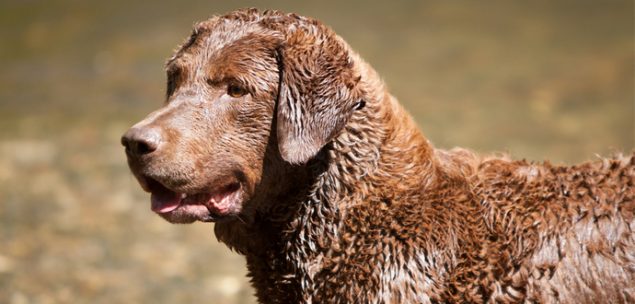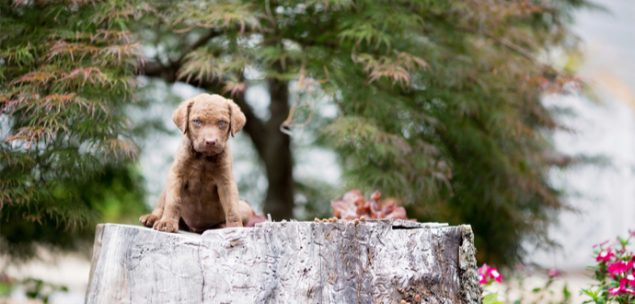The Chesapeake Bay Retriever is the only American retriever breed. However, its origin is not the only thing that makes the Chesapeake Bay Retriever special: The Chessie can also fascinate with its tireless enthusiasm or its singing and laughter.
History of the Chesapeake Bay Retriever
According to legend, the two original Chesapeakes were found on board a stranded ship in 1807. However, documents from 1803 suggest that the Chesapeake Bay Retriever has been around for longer.
Sailor and Canton, the two found dogs, appear to be the ancestors of today’s Chesapeakes. However, due to various crosses (presumably with Curly-Coated Retrievers, Flat-Coated Retrievers, Irish Water Spaniels, Setters, and Coonhounds), they look different today.
Since the dogs were supposed to help with hunting, their character was always the focus of the breeding processes. Their main purpose was to retrieve the shot game (ducks, geese, etc.). Therefore, it was necessary for the Chesapeake Bay Retriever to be cold-resistant, have endurance, and be able to swim and dive.
Its club history mainly took place between the 19th and 20th centuries:
- 1878 – Registration by the American Kennel Club
- 1918 – Foundation of the American Chesapeake Bay Retriever Club
- 1965 – Recognition as a separate breed by the FCI
Breed Overview
GROUP: Sporting
HEIGHT: 21 to 24 inches (female), 23 to 26 inches (male)
WEIGHT: 55 to 70 pounds (female), 65 to 80 pounds (male)
COAT: Wiry, wavy, medium-length
COAT COLOR: Shades of brown, deadgrass (yellow to tan), sedge (red), tan
LIFE SPAN: 10 to 13 years
TEMPERAMENT: Active, energetic, loyal
HYPOALLERGENIC: No
ORIGIN: United States
Nature and Character
The Chesapeake Bay Retriever is a diligent working dog with corresponding characteristics. To help with hunting, it must be enduring, confident, brave, and resilient. Since it is quite insensitive to cold and is an excellent swimmer, it is preferably used for waterfowl hunting. Due to its tireless enthusiasm for work, it has also proven itself in other areas, such as rescue work, searching, or security.
Although the Chesapeake is a tough working dog, it has a sensitive core. It is not only described as “calm, friendly, and affectionate,” but also loves children.
Despite its amiable side, the Chesapeake can be headstrong. This is a characteristic remnant that it knows from the independent decisions it made during its working life.
| Affection Level | High |
| Friendliness | Medium |
| Kid-Friendly | Medium |
| Pet-Friendly | Medium |
| Exercise Needs | High |
| Playfulness | Medium |
| Energy Level | High |
| Trainability | High |
| Intelligence | High |
| Tendency to Bark | Medium |
| Amount of Shedding | Medium |

Acquisition of a Chesapeake Bay Retriever
The Chesapeake Bay Retriever is an American purebred dog that has remained true to its country of origin – despite globalization. Consequently, the hunting breed is rarely found in Europe.
Note: While the rarity value has the advantage that the exotic breed is something very special, it can also mean that the buyer has to wait a long time for their dream dog and cross several states to make the purchase.
But even if you are separated by several hundred kilometers from your desired breeder, a home visit can be worthwhile before making a purchase decision. After all, Chesapeake Bay Retrievers are a hunting breed that is very energetic and has very specific behaviors. You should personally get to know the dogs to make sure that the breed is really suitable for you.
What to Look for When Buying?
Chesapeake Bay Retriever puppies – important notes for purchase.
The breeder should:
- determine through targeted questions whether you can meet the requirements of a hunting dog owner,
- show you the mother dog and guide you through the breeding facility,
- be affiliated with the American Retriever Club,
- provide medical care for their animals,
- have pedigree certificates,
- have a sales permit,
- start socializing the puppies,
- adhere to the minimum age for delivery (eight weeks)
- and provide advisory support.
The current average price is $1,300.
Note: Chesapeake Bay Retrievers and Chesapeake mixes are usually not offered in animal shelters because dogs of this type are very rare. Therefore, there is no inexpensive and quick alternative to the breeder.
Development and Training of the Puppy
The Chesapeake Bay Retriever needs work as a foundation to be receptive to its owner’s training. Chesapeakes that have no task often develop an exaggerated guarding instinct and impulsivity problem.
Another training focus is early socialization. This allows the Chesapeake to learn how to interact with other people and dogs.
A lack of patience is another characteristic peculiarity of the Chesapeake. The low frustration threshold requires adherence to rules and a clear daily structure. Through impulse control exercises and relaxation training, the Retriever can also learn to handle frustration adequately.
In general, it can be said that the Chesapeake needs a consistent and assertive owner. In experienced hands, there is a high likelihood that it can develop into an obedient all-around companion.
Although training the Chesapeake can be challenging at times, it can also be considered as a first dog. However, it is necessary for the dog owner to inform themselves about the dog’s needs and consciously decide to take on the training tasks.
Note: A peculiarity of the Chesapeake is that it usually only follows its dog owner’s lead. In unfamiliar hands (for example, dog sitters/holiday care), it can be a real stubborn.

How to Keep a Chesapeake Bay Retriever?
Since the Chesapeake Bay Retriever has a strong need for occupation, the time commitment in its keeping is one of the main criteria. You can expect to give your Retriever several hours of challenging tasks daily. The Chesapeake is most suitable for professional dog owners, such as hunters, security personnel, or therapeutic dog handlers.
Furthermore, the living environment should be tailored to the needs of the Chesapeake Bay Retriever. Dogs of this kind feel most comfortable when they have a fenced garden they can protect and when they can swim nearby. Since an apartment restricts the dog’s movements and hinders its guarding instinct, central city living is not the optimal form of housing.
So the Chesapeake is not a typical apartment dog. Additionally, it has specific requirements for its owner. The owner must at least have a genuine passion for hunting dogs and be very athletic themselves. Otherwise, the Chesapeake is a friendly companion who can live well in the midst of a family. Its family-friendly nature also includes the presence of other pets and children.
Activities with the Chesapeake Bay Retriever
The Chesapeake Bay Retriever is a hunting breed that needs to be mentally and physically stimulated according to its instincts.
Hunting Applications:
- Retrieving
- Tracking
- Scavenging
- Brushing
- Marking
Since many Chesapeake enthusiasts do not work in the hunting industry, they must find comparable areas of application to engage with their four-legged companion.
Alternative Tasks:
- Retrieving exercises with dummies
- Agility
- Obedience
- Mantrailing
- Training as a protection or rescue dog
Health and Care
The Chesapeake Bay Retriever is a robust dog. Nevertheless, there is a breed-specific susceptibility to the following diseases:
- Joint problems
- Spinal cord diseases
However, since hereditary transmission can be prevented through health screening, dogs from reputable breeders are usually healthy. Conscientious breeders not only check the physical but also the character traits and implement strict selection measures for behavioral defects. The goal of this strict selection of breeding dogs is to minimize the risk of behavioral abnormalities (such as nervousness or aggression) in subsequent generations.
The Chesapeake’s diet is generally undemanding. However, since hunting dogs require a high-energy diet, it is important to provide a diet rich in calories. With a high-calorie diet, it is important to ensure that puppies do not grow too quickly and that adult dogs do not become overfed.
Otherwise, this could lead to, among other things, overweight and bone and joint problems. Regardless of specific needs (such as puppies, pre-existing conditions, and seniors), a good diet should contain at least 70% high-quality meat and be nutrient-rich.
The Chesapeake Bay Retriever’s short coat is water and dirt repellent, making it extremely easy to care for. Occasional brushing is not mandatory, but it has the advantage of allowing better air circulation in the undercoat.
Interesting Facts
Surprising facts about the Chesapeake:
- The Chesapeake Bay Retriever has a unique way of communicating. Instead of just barking, it can make a variety of sounds (for example, a type of yodeling/singing, a dove-like cooing, and humming).
- The Chesapeake is also known for being able to grin broadly and even laugh in joyful moments.
- In addition to its breed name “Chesapeake Bay Retriever,” the American hunting dog is also known by the short forms “Chessie” and “Chesapeake.”
Conclusion
The Chessie is a working dog with a great passion for hunting. To make the Chesapeake happy, the owner must meet the needs of their fluffy friend. This can be done in the original way or through substitute activities.
A well-exercised Chesapeake Bay Retriever is a socially acceptable family dog. He loves the presence of his caregivers and enjoys being part of the holiday activities.


